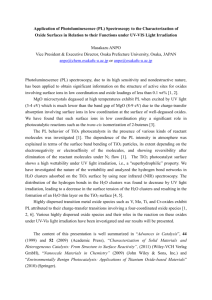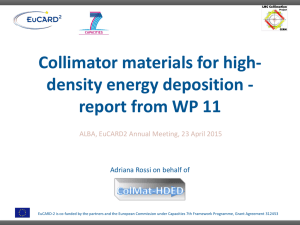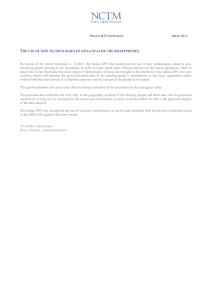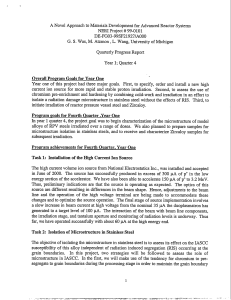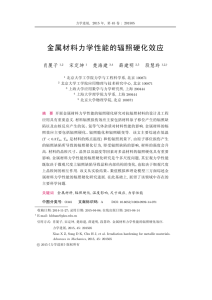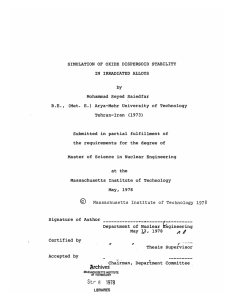Andrew London - APT of ion-irradiated model
advertisement
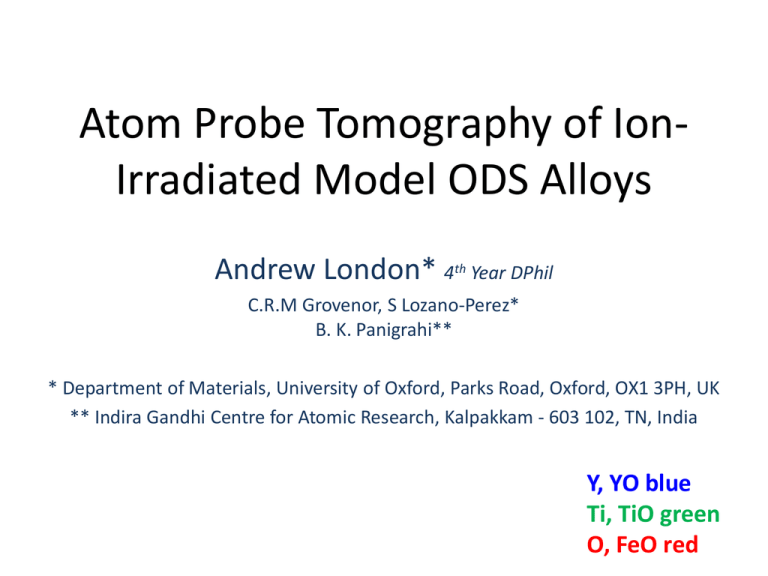
Atom Probe Tomography of IonIrradiated Model ODS Alloys Andrew London* 4th Year DPhil C.R.M Grovenor, S Lozano-Perez* B. K. Panigrahi** * Department of Materials, University of Oxford, Parks Road, Oxford, OX1 3PH, UK ** Indira Gandhi Centre for Atomic Research, Kalpakkam - 603 102, TN, India Y, YO blue Ti, TiO green O, FeO red Purpose of my research What questions are we trying to answer? • Oxide dispersion strengthened steel: – What are the dispersed oxides, structure/chemistry? So we can control them and therefore the materials’ properties. – What is the influence of alloy chemistry on oxide particles, specifically chromium? – What is the influence of ion-irradiation? Purpose of my research What questions are we trying to answer? • Oxide dispersion strengthened steel: – What are the dispersed oxides, structure/chemistry? So we can control them and therefore the materials’ properties. – What is the influence of alloy chemistry on oxide particles, specifically chromium? – What is the influence of ion-irradiation? London, A. J., et al. "Comparison of atom probe tomography and transmission electron microscopy analysis of oxide dispersion strengthened steels." Journal of Physics: Conference Series. Vol. 522. No. 1. IOP Publishing, 2014. Purpose of my research What questions are we trying to answer? • Oxide dispersion strengthened steel: – What are the dispersed oxides, structure/chemistry? So we can control them and therefore the materials’ properties. – What is the influence of alloy chemistry on oxide particles, specifically chromium? – What is the influence of ion-irradiation? Expectation: High temperature As-received 500 C 75 dpa 500 C 150 dpa Lescoat, M-L., et al. Acta Materialia 78 (2014): 328-340. Allen, Todd R., et al. Journal of Nuclear Materials 375.1 (2008): 26-37. He, Jianchao, et al. Journal of Nuclear Materials 455.1 (2014): 41-45. Expectation: Low temperature Room temperature “the 100 dpa, −75 °C samples data set showed no significant clustering … Y, Ti, and O were randomly distributed in solid solution.” Certain, A., et al. Journal of Nuclear Materials 434.1 (2013): 311-321. (own work) Irrd. at 120K (a), and as-received (b) Lescoat, M-L., et al. Acta Materialia 78 (2014): 328-340. Indian Programme on ODS Materials • Currently working on a ODS cladding tube alloy. • Fe-9Cr-2W-0.1C-0.2Ti-0.35Y2O3 Pre-alloyed powder Nanocrystalline yttria Clad-tubes with 6.6 mm O.D., 0.45 mm thick and 4.2 m length have been successfully produced My Collaboration with Indira Gandhi Centre for Atomic Research (IGCAR) Three model alloys produced by extrusion to study the influence of alloy content. Nominal Compositions: (wt %) • Fe–14Cr–0.2Ti–0.3Y2O3 • Fe–0.2Ti–0.3Y2O3 • Fe–0.3Y2O3 Methods: Example TEM and APT of the same sample Carbon on grain boundary Large Yttrium & Oxygen particle Oxygen Atom Probe data Y & YO Ti & TiO 100 nm Low-temperature irradiation As-received Fe-14Cr-0.2Ti-0.3Y2O3 50 nm >50 dpa @ 120K Low-temperature irradiation 20 nm surface Y/YO TiO/Ti 150K Ion Irradiation of Fe-Ti-Y2O3 ODS alloys to 100 dpa Carbide Matrix 100 nm diffuse Y-Ti clusters 15 Carbon Erf fit Carbon % 50 nm 10 5 0 0 Cr-oxide contamination particle 20 40 Distance nm 60 80 High-temperature irradiation As-received Fe-14Cr-0.2Ti-0.3Y2O3 Increased Ti content of the clusters, but no significant change to number density or size distribution >50 dpa @ 900K 50 nm High-temperature irradiation The high-yttrium content clusters are lost, more Ti-rich oxides are observed and the average Ti-fraction of the clusters increases. Fe14Cr-0.2Ti-0.3Y2O3 ~50 dpa, APT data High-temperature irradiation No significant change in radius, but reduction in average number density with irradiation at 500 to 600 C. Fe14Cr-0.2Ti-0.3Y2O3 ~50 dpa, APT data After cryo-irradiation: 50 nm Annealed @ 900K Irradiated @ 900K 0 dpa 100 dpa 50 nm Irradiated @ 900K (after 120K irradiation) 50 nm grain boundaries High number density of small “flat” clusters Monnet et al. JNM 335.3 (2004): 311-321. 800K, 78.8 dpa, 25 days 10 nm Preliminary conclusions • Irradiation at low temperature does not homogenise the solute distribution as reported by others [1,2], but does partially dissolve the particles. • Subsequent annealing results in similar particles to the original, even at “low” temperatures (900K). • Subsequent ion-irradiation at high temperature forms a high number density of very small clusters, with a high solute concentration on the grain boundaries. • It is possible to use ion irradiation as an analogue for neutron damage but care is required to design appropriate experiments. [1] Certain, A., et al. Journal of Nuclear Materials 434.1 (2013): 311-321. [2] Parish, CM., et al. Journal of Nuclear Materials 445.1 (2014): 251-260. Any Questions?
